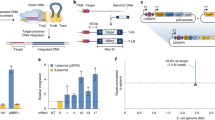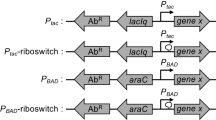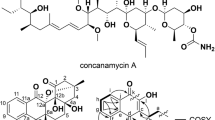Abstract
For many bacteria, cloning and expression systems are either scarce or nonexistent. We constructed several mini-Tn7 vectors and evaluated their potential as broad-range cloning and expression systems. In bacteria with a single chromosome, including Pseudomonas aeruginosa, Pseudomonas putida and Yersinia pestis, and in the presence of a helper plasmid encoding the site-specific transposition pathway, site- and orientation-specific Tn7 insertions occurred at a single attTn7 site downstream of the glmS gene. Burkholderia thailandensis contains two chromosomes, each containing a glmS gene and an attTn7 site. The Tn7 system allows engineering of diverse genetic traits into bacteria, as demonstrated by complementing a biofilm-growth defect of P. aeruginosa, establishing expression systems in P. aeruginosa and P. putida, and 'GFP-tagging' Y. pestis. This system will thus have widespread biomedical and environmental applications, especially in environments where plasmids and antibiotic selection are not feasible, namely in plant and animal models or biofilms.
This is a preview of subscription content, access via your institution
Access options
Subscribe to this journal
Receive 12 print issues and online access
$259.00 per year
only $21.58 per issue
Buy this article
- Purchase on Springer Link
- Instant access to full article PDF
Prices may be subject to local taxes which are calculated during checkout




Similar content being viewed by others
Accession codes
References
Craig, N.L. in Mobile DNA (eds. Berg, D.E. & Howe, M.M.) 211–225 (American Society for Microbiology, Washington, D.C., 1989).
Craig, N.L. Transposon Tn7. Curr. Top. Microbiol. Immunol. 204, 27–48 (1996).
Peters, J.E. & Craig, N.L. Tn7: smarter than we thought. Nat. Rev. Mol. Cell Biol. 2, 806–814 (2001).
McKown, R.L., Orle, K.A., Chen, T. & Craig, N.L. Sequence requirements of Escherichia coli attTn7, a specific site of transposon Tn7 insertion. J. Bacteriol. 170, 352–358 (1988).
Hoang, T.T., Karkhoff-Schweizer, R.R., Kutchma, A.J. & Schweizer, H.P. A broad-host-range Flp-FRT recombination system for site-specific excision of chromosomally-located DNA sequences: application for isolation of unmarked Pseudomonas aeruginosa mutants. Gene 212, 77–86 (1998).
Hojberg, O., Schnider, U., Winteler, H.V., Sorensen, J. & Haas, D. Oxygen-sensing reporter strain of Pseudomonas fluorescens for monitoring the distribution of low-oxygen habitats in soil. Appl. Environ. Microbiol. 65, 4085–4093 (1999).
Bao, Y., Lies, D.P., Fu, H. & Roberts, G.P. An improved Tn7-based system for the single-copy insertion of cloned genes into the chromosomes of Gram-negative bacteria. Gene 109, 167–168 (1991).
Klausen, M. et al. Biofilm formation by Pseudomonas aeruginosa wild type, flagella and type IV pili mutants. Mol. Microbiol. 48, 1511–1524 (2003).
Koch, B., Jensen, L.E. & Nybroe, O. A panel of Tn7-based vectors for insertion of the gfp marker gene or for delivery of cloned DNA into Gram-negative bacteria. J. Microbiol. Methods 45, 187–195 (2001).
Miller, V.L. & Mekalanos, J.J. A novel suicide vector and its use in construction of insertion mutations: osmoregulation of outer membrane proteins and virulence determinants in Vibrio cholerae requires toxR. J. Bacteriol. 170, 2575–2583 (1988).
Staley, T.E., Lawrence, E.G. & Drahos, D.J. Variable specificity of Tn7::lacZY insertion into the chromosome of root-colonizing Pseudomonas putida strains. Mol. Ecol. 6, 85–87 (1997).
Center for Disease Control and Prevention. Biological and chemical terrorism: strategic plan for preparedness and response. Recommendations of the CDC strategic planning workgroup. Morb. Mortal. Wkly. Rep. 49, 1–4 (2000).
Dance, D.A.B. in Manson's Tropical Diseases (ed. Cook, G.C.) 925–930 (W.B. Saunders Company Ltd., London, 1996).
Howe, C. in The Oxford Medicine (ed. Christian, H.A.) 185–202 (Oxford University Press, New York, 1950).
Schweizer, H.P. & de Lorenzo, V. in The Pseudomonads - Genomics, life style and molecular architecture (ed. Ramos, J.L.) 317–350 (Kluwer Academic/Plenum, New York, 2004).
Schweizer, H.P. A method for construction of bacterial hosts for lac-based cloning and expression vectors: α complementation and regulated expression. Biotechniques 17, 452–456 (1994).
Karkhoff-Schweizer, R.R. & Schweizer, H.P. Utilization of mini-Dlac transposable element to create an alpha-complementation and regulated expression system for molecular cloning in Pseudomonas aeruginosa. Gene 140, 7–15 (1994).
Trieu-Cuot, P., Carlier, C., Poyart-Salmeron, C. & Courvalin, P. An integrative vector exploiting the transposition properties of Tn1545 for insertional mutagenesis and cloning of genes from gram-positive bacteria. Gene 106, 21–27 (1991).
Stover, C.K. et al. New use of BCG for recombinant vaccines. Nature 351, 456–460 (1991).
Hoang, T.T., Kutchma, A.J., Becher, A. & Schweizer, H.P. Integration proficient plasmids for Pseudomonas aeruginosa: site-specific integration and use for engineering of reporter and expression strains. Plasmid 43, 59–72 (2000).
Kieser, T., Bibb, M.J., Buttner, M.J., Chater, K.F. & Hopwood, D.A. Practical Streptomyces genetics (The John Innes Foundation, Colney, Norwich, UK, 2000).
Charpentier, E. et al. Novel cassette-based shuttle vector system for Gram-positive bacteria. Appl. Environ. Microbiol. 70, 6076–6085 (2004).
de Lorenzo, V., Herrero, M., Jakubzik, U. & Timmis, K.N. Mini-Tn5 transposon derivatives for insertion mutagenesis, promoter probing, and chromosomal insertion of cloned DNA in Gram-negative bacteria. J. Bacteriol. 172, 6568–6572 (1990).
Stellwagen, A.E. & Craig, N.L. Avoiding self: two Tn7-encoded proteins mediate target immunity in Tn7 transposition. EMBO J. 16, 6823–6834 (1997).
Holloway, B.W. Genetic recombination in Pseudomonas aeruginosa. J. Gen. Microbiol. 13, 572–581 (1955).
Chuanchuen, R. et al. Cross-resistance between triclosan and antibiotics in Pseudomonas aeruginosa is mediated by multidrug efflux pumps: exposure of a susceptible strain to triclosan selects nfxB mutants overexpressing MexCD-OprJ. Antimicrob. Agents Chemother. 45, 428–432 (2001).
Brett, P.J., DeShazer, D. & Woods, D.E. Burkholderia thailandensis sp. nov., a Burkholderia pseudomallei-like species. Int. J. Syst. Bacteriol. 48, 317–320 (1998).
De Kievit, T.R., Gillis, R., Marx, S., Brown, C. & Iglewski, B.H. Quorum-sensing genes in Pseudomonas aeruginosa biofilms: their role and expression patterns. Appl. Environ. Microbiol. 67, 1865–1873 (2001).
Sambrook, J. & Russell, D.W. Molecular Cloning (Cold Spring Harbor Laboratory Press, Cold Spring Harbor, NY, 2001).
Figurski, D.H. & Helinski, D.R. Replication of an origin-containing derivative of plasmid RK2 dependent on a plasmid function provided in trans. Proc. Natl. Acad. Sci. USA 76, 1648–1652 (1979).
Acknowledgements
H.P.S. was supported by National Institutes of Health grant AI058141. We thank K. Giesler and K. Quinn for their contributions to this project, and R. Gillis (University of Rochester) for assisting with biofilm experiments.
Author information
Authors and Affiliations
Corresponding author
Ethics declarations
Competing interests
The authors declare no competing financial interests.
Supplementary information
Supplementary Fig. 1
Maps of mini-Tn7 suicide delivery base vectors. (PDF 112 kb)
Supplementary Fig. 2
Maps of selected mini-Tn7 elements. (PDF 150 kb)
Supplementary Fig. 3
Mini-Tn7 insertion does not affect GlmS expression. (PDF 93 kb)
Supplementary Fig. 4
Stability of mini-Tn7 insertions in the absence of selection. (PDF 156 kb)
Supplementary Table 1
Plasmid vectors derived in this study and GenBank accession numbers. (PDF 86 kb)
Supplementary Table 2
glmS genes in annotated bacterial genomes. (PDF 181 kb)
Rights and permissions
About this article
Cite this article
Choi, KH., Gaynor, J., White, K. et al. A Tn7-based broad-range bacterial cloning and expression system. Nat Methods 2, 443–448 (2005). https://doi.org/10.1038/nmeth765
Received:
Accepted:
Published:
Issue Date:
DOI: https://doi.org/10.1038/nmeth765
This article is cited by
-
Leaf microbiome dysbiosis triggered by T2SS-dependent enzyme secretion from opportunistic Xanthomonas pathogens
Nature Microbiology (2024)
-
Assessing microbiome population dynamics using wild-type isogenic standardized hybrid (WISH)-tags
Nature Microbiology (2024)
-
Chromosomal barcodes for simultaneous tracking of near-isogenic bacterial strains in plant microbiota
Nature Microbiology (2024)
-
Effects of plant tissue permeability on invasion and population bottlenecks of a phytopathogen
Nature Communications (2024)
-
Use of Cas9 Targeting and Red Recombination for Designer Phage Engineering
Journal of Microbiology (2024)



